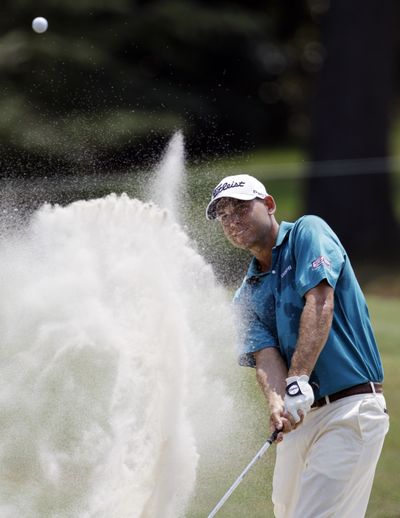Bunkers create big problems at PGA

JOHNS CREEK, Ga. – The longest par 70 in major championship history. Water on half of the holes.
There was plenty of evidence that Atlanta Athletic Club would be a strong test for the PGA Championship, and it has proven to be just that. But perhaps the biggest challenge is something not many players considered before they arrived.
The bunkers.
Not just where they are located, but the sand that fills them.
“The sand is very heavy,” D.A. Points said. “The sand is very powdery, so your ball rolls into it; it does not sit on the top of the sand. It sits a sixth of the golf ball down. It’s almost better if you can somehow hit a shot into a place where somebody has already raked.”
Rickie Fowler was 3 under in the third round Saturday when he caught a bunker short and left of the eighth green. His next shot was a shocker, sailing some 40 yards over the green, behind a row of bushes, almost on part of the fourth tee. He wound up with triple bogey, erasing the three birdies he had made.
Tiger Woods had a soft lie and an awkward stance in the bunker on No. 11 in the second round. He blasted out, turned his head away when sand flew into his eyes, and was able to see again just in time to take in his ball racing across the green and into the water.
“Bunker play wouldn’t really be a strength at the best of times,” Graeme McDowell said after missing the cut. “But out of these traps, they are just unplayable.”
Scott Verplank managed just fine with some of the lies he had Friday, saving par all four times he was in the sand around the green. Perhaps most telling was one of the purest shots of the tournament.
Paul Casey was in a bunker just right of the 18th fairway – the same bunker where moments earlier Woods put a 4-iron into the water. When he saw his ball, he realized he had received a good break. Why? Because it was in a spot that had been raked.
Needing par to make the cut, he hit 4-iron to 18 feet and two-putted to make it to the weekend.
“It was a spot that had a lot of action,” Casey said. “The caddies had raked it and I had a good lie. This sand is lumpy, clumpy, whatever the word is. And it’s incredibly light. So the weight of the ball sits down. You can’t get at the back of the ball. That’s why you’re seeing either low shots or chunks. There’s no in between.”
In a way, it’s like links golf – avoid bunkers at all costs because it can be a half-shot penalty.
Casey has no problem with that. Bunkers are supposed to be hazards and players aren’t supposed to hit into them. Too many times on too many courses, players have tried to put it in the sand for an easier shot.
“Bunkers are hazards, but it has to be in balance with the rest of the course,” he said. “These are making guys look silly. And it’s killing creativity and shotmaking.”
Casey is out of contention. He barely made the cut, and that quadruple-bogey 8 sent him to a 78. His only concern is whether the bunkers will make a difference to someone down the stretch today, with the final major of the year on the line.
“I just hope it doesn’t cost someone coming in,” he said.
A bunker getting a lot of attention on the final hole of the PGA Championship? Now that sounds familiar. Dustin Johnson was in one on the last hole at Whistling Straits last year, except he didn’t know he was in a bunker.
In Atlanta, there’s no mistaking them.